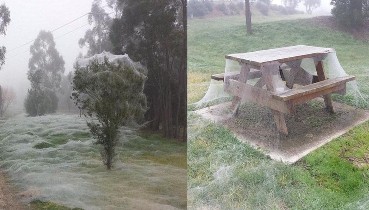

15 Smallest Birds in the World
For this reason, we’re presenting you today with the smallest birds in the world! While most of the tiniest birds are hummingbirds, we also feature some small passerine birds.
Without further ado, let’s talk about these tiny birds!
15 Smallest Birds in the World
Here are the world’s smallest birds in ascending order: from the smallest to the bigger ones.
1. Bee Hummingbird – The Smallest Birds in the World

Bee hummingbirds (Mellisuga helenae) are the smallest birds in the world and measure only 2.25 inches long. Weighing only 0.07 ounces, these little birds are the tiniest species of hummingbird.
Typically, hummingbirds have slender bodies, but bee hummingbirds are plump and look slightly different from the other hummingbird species.
It is easy to distinguish between male and female bee hummingbirds, as the males are brighter and have bluish upper parts, while the females are less colorful and greenish.
Because these are the tiniest birds in the world, you can imagine they don’t lay many eggs. Females lay two eggs which are as big as coffee beans.
Unlike other birds that mate for life, these petite birds are polygamous and have multiple partners throughout their life.
On a typical flight, their wings can beat 80 times per second. However, that increases to 200 beats per second when they engage in a courtship flight.
2. Esmeraldas Woodstar – The Smallest Birds in South America

One of the rare animals is this neotropical species of birds from the hummingbird family, the Esmeralda woodstars (Chaetocercus berlepschi) grow only up to 2.5 inches long and weigh almost 0.8 ounces.
Although there are six subspecies in the woodstar family, the difference between them is not clearly known because they are poorly studied.
Primarily found in semi-deciduous or evergreen forests of Ecuador in South America, these little birds thrive on flowering shrubs and trees.
Esmeraldas is sexually dimorphic, and the key difference that sets the males apart from the females is the bright purple throat of the males.
3. Bumblebee Hummingbird

The bumblebee hummingbird (Selasphorus heloisa) is the second-smallest bird, only after a member of its own family – the bee hummingbird.
The bumblebee hummingbirds grow only up to 3 inches and weigh no more than 0.1 ounces.
These little birds feed on nectar and fly from flower to flower, searching for food. On average, they visit up to 1,500 flowers per day.
Males are super territorial and aggressively defend their territories in case of intrusions. Female bumblebees are more of the caregivers.
When nesting, the female hummingbirds are known for their hunting prowess and can capture almost 2,000 insects in a single day!
4. Cape Penduline Tit – The Smallest Birds in Africa

Cape penduline tits (Anthoscopus minutus) are one of the smallest bird species native to Africa. These birds grow only up to 3.15 inches in length.
Found in Angola, Botswana, Zimbabwe, and South Africa, the natural habitat of these birds is dry, tropical dry shrublands or Mediterranean-type shrubby vegetation as well.
These birds put in a lot of effort to build their nests and use silken fibers from different plants. The bird nest is built tactfully and has one actual entrance and one false entrance.
The well-designed nest keeps the birds and their little ones safe from snakes and other nest predators.
5. Pale-Billed Flowerpecker

Pale-billed flowerpeckers (Dicaeum erythrorhynchos) are known to be the smallest birds spotted in South Asian countries.
They are tiny and grow only up to 3.15 inches, and can weigh a maximum of 0.28 ounces. The pinkish color of the beaks of these birds is why they are named ‘pale-billed flowerpecker.’
Typically found in urban areas, mangrove forests, and deciduous forests. Omnivorous birds prey on small insects and spiders.
The pale-billed flowerpecker breed during January and June but are known to have raised another brood, although only in specific regions.
6. Common Firecrest

Common firecrests (Regulus ignicapilla) are the brighter versions of the goldcrests and are super easy to recognize, thanks to the yellow-black stripe on their neck.
These miniature birds belong to the kinglet family of birds, the same as the goldcrest.
They grow only 3.5 inches long and have a wingspan of 5.11 inches. Weighing up to 0.17 birds, these are one of the smallest bird species in the world.
They love eating spiders, moth eggs, and small insects and are common birds often found in gardens in cities.
Apart from this, the common firecrests make evergreen woodlands their homes and are often spotted as part of larger flocks of other small birds.
7. Weebill – The Smallest Birds in Australia

Weebills (Smicrornis brevirostris) are the smallest birds in Australia and grow only up to 3.5 inches long. These birds are found across mainland Australia primarily in dry eucalyptus forests and malle.
These birds are known to help maintain the health of trees as they eat a range of insects that would otherwise harm the trees.
Weebills don’t have a fixed breeding season, which depends entirely on climatic conditions.
These birds can breed at any time of the year but most commonly breed from July to May.
8. Costa’s Hummingbird

Another member of the hummingbird family, Costa’s hummingbirds (Calypte costae) are tiny and weigh not more than 0.11 ounces.
The maximum length these hummingbirds grow up to is 3-3.5 inches, with a wingspan of 4.3 inches.
These birds mostly live in deserts, semi-deserts, or open meadows in North America.
If the living conditions in their natural habitat become unbearable or the resources there become scarce, Costa’s hummingbirds consider migrating to other countries.
Costa’s hummingbirds reach sexual maturity when they turn a year old. And the male and female Costas breed between January to May every year but do not form exclusive pairs.
9. Goldcrest – The Smallest Birds in Britain

Also known as Britain’s smallest bird, the average weight of the goldcrest (Regulus regulus) spans from 0.20 – 0.40 ounces.
They grow only 3.7 inches long and have a wingspan of 6.1 inches, making them one of the smallest bird species in the world.
Spread across Europe, the goldcrests are also found in the Himalayas and Japan. These birds may be tiny but are powerful enough to sustain their annual migratory journeys, which are super long.
The size of the birds made ornithologists wonder how exactly they crossed the North Sea without any aid.
Initially, they believed that these birds might be taking assistance from other migratory birds – but that wasn’t the case – these tiny birds actually flew across thousands of miles all by themselves!
10. Calliope Hummingbird – The Smallest Birds in the United States and Canada

The Calliope hummingbird (Selasphorus calliope) is the smallest bird in North America and, despite its super tiny size, is known to chase off larger birds during the breeding season.
The Calliope hummingbirds are territorial, and this only intensifies during the breeding season.
They grow up to 3.9 inches long and weigh only 1/10th of an ounce.
Their size may make you want to underestimate their strength, but like the other tiny birds, even the Calliope hummingbird is pretty tough when migrating long distances.
In fact, it is the only smallest long-distance migrant in the world and comfortably travels up to 5,000 miles yearly to distant lands.
11. Spotted Pardalote

Spotted pardalotes (Pardalotus punctatus) are tiny birds and grow only up to 3.1 to 4 inches. It is one of the most colorful birds in Australia, which is why it is also known as the ‘diamond bird.’
The birds are mainly sedentary but often move to higher-elevation regions in their natural habitat.
They mostly move during autumn and winter. The breeding season of spotted pardalotes spans from June to January, during which both parents equally share responsibilities – from building the nest to incubating the eggs and raising the young hatchings.
12. Brown Gerygone

Brown gerygones (Gerygone mouki) are tiny pale birds found in different regions across the Australian continent.
The maximum length the birds grow up to is 4 inches, weighing between 0.17 – 0.21 ounces.
The mating season of the brown gerygone spans from September to February, during which the Gery gone couple builds a nest using a variety of materials such as webs, moss, roots, lichens, and feathers.
After this, the female lays around 2-4 eggs in the nest, incubating for 12-14 days. Fourteen days post-hatching, the chicks are ready to leave the nest.
13. Verdin

Verdins (Auriparus flaviceps) grow up to 4.5 inches in length and have tiny bodies with medium-sized tails.
They are gray and have bright yellow heads and pointed beaks, which makes it easy to spot these birds.
They are insectivorous and feed on different insects on trees. Along with insects, these birds also consume the soft mast of trees.
Verdins are monogamous and stay with their partners throughout the breeding season. Once the breeding season winds up, the verdins go their own way.
Both males and females contribute to building the nest and raising the hatchlings.
Did you know? The Inaccessible Island rail is the smallest flightless bird in the world. They measure 6 inches long and weigh no more than 1.7 ounces.
14. Lesser Goldfinch

Lesser goldfinches (Spinus psaltria) are tiny and quick birds growing more than 3.5 – 4.7 inches in length and 0.42 ounces in weight.
It is a songbird and is found in deep forests as well as in gardens in suburban areas from southern North America to northern South America.
They’re different from other members of their species regarding the habitat they choose – the lesser goldfinches are often spotted in large flocks near water bodies and feeding sites.
Males become territorial during the breeding season and put their best foot forward to court the females and, ultimately, choose one partner.
The females build the nest, and the male watches over her as she completes building the nest in 4-8 days.
15. Red-Cheeked Cordon-Bleu

The red-cheeked cordon-bleu (Uraeginthus bengalus) is a tiny finch that measures just 4.9 – 5.1 inches.
Depending on their region, the birds may weigh anything between 9.9 – 11 ounces.
The males are easy to spot, as they are bright and attractive, featuring blue, brown, and bright yellow-colored feathers. The females, on the other hand, are paler.
The natural habitat of these birds is central and eastern Africa – and they are found across these regions, except in interior areas of forests and high elevations.
These birds are granivores and feed on a variety of seeds, including millet and grass seeds.
Recommended Videos
 Top ten archaeological discoveries1241 views
Top ten archaeological discoveries1241 views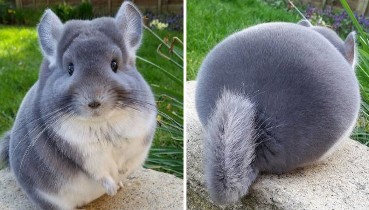 Adorable Violet Chinchillas Look Perfectly Round From Behind64 views
Adorable Violet Chinchillas Look Perfectly Round From Behind64 views-
Advertisements
 30+ Photos That Prove Walmart Is One Wacky Place1404 views
30+ Photos That Prove Walmart Is One Wacky Place1404 views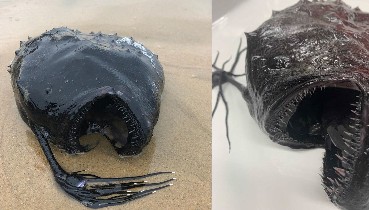 Angler Fish Washed Ashore1727 views
Angler Fish Washed Ashore1727 views 30 Stunning “Rose Garden” Ideas for Your Backyard1018 views
30 Stunning “Rose Garden” Ideas for Your Backyard1018 views Rainbow mountains in Peru1297 views
Rainbow mountains in Peru1297 views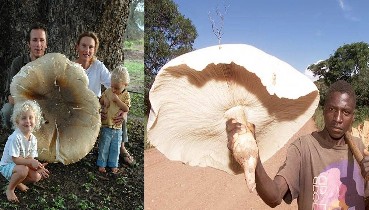 The World’s Largest Edible Mushroom Lives in Symbiosis with Termites and That’s Why It Grows So Huge409 views
The World’s Largest Edible Mushroom Lives in Symbiosis with Termites and That’s Why It Grows So Huge409 views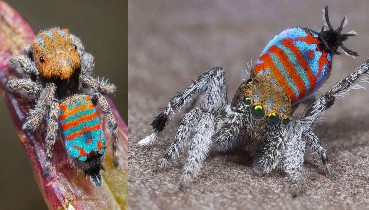 15 of the Strangest Animals in the World and Where to See Them13395 views
15 of the Strangest Animals in the World and Where to See Them13395 views



